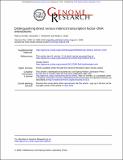| dc.contributor.author | Gordan, Raluca | |
| dc.contributor.author | Hartemink, Alexander J. | |
| dc.contributor.author | Bulyk, Martha L. | |
| dc.date.accessioned | 2013-02-06T20:56:46Z | |
| dc.date.available | 2013-02-06T20:56:46Z | |
| dc.date.issued | 2009-08 | |
| dc.date.submitted | 2009-03 | |
| dc.identifier.issn | 1088-9051 | |
| dc.identifier.uri | http://hdl.handle.net/1721.1/76758 | |
| dc.description.abstract | Transcriptional regulation is largely enacted by transcription factors (TFs) binding DNA. Large numbers of TF binding motifs have been revealed by ChIP-chip experiments followed by computational DNA motif discovery. However, the success of motif discovery algorithms has been limited when applied to sequences bound in vivo (such as those identified by ChIP-chip) because the observed TF–DNA interactions are not necessarily direct: Some TFs predominantly associate with DNA indirectly through protein partners, while others exhibit both direct and indirect binding. Here, we present the first method for distinguishing between direct and indirect TF–DNA interactions, integrating in vivo TF binding data, in vivo nucleosome occupancy data, and motifs from in vitro protein binding microarray experiments. When applied to yeast ChIP-chip data, our method reveals that only 48% of the data sets can be readily explained by direct binding of the profiled TF, while 16% can be explained by indirect DNA binding. In the remaining 36%, none of the motifs used in our analysis was able to explain the ChIP-chip data, either because the data were too noisy or because the set of motifs was incomplete. As more in vitro TF DNA binding motifs become available, our method could be used to build a complete catalog of direct and indirect TF–DNA interactions. Our method is not restricted to yeast or to ChIP-chip data, but can be applied in any system for which both in vivo binding data and in vitro DNA binding motifs are available. | en_US |
| dc.description.sponsorship | National Science Foundation (U.S.). (CAREER Award 0347801) | en_US |
| dc.language.iso | en_US | |
| dc.publisher | Cold Spring Harbor Laboratory Press | en_US |
| dc.relation.isversionof | http://dx.doi.org/10.1101/gr.094144.109 | en_US |
| dc.rights | Creative Commons Attribution Non-Commercial | en_US |
| dc.rights.uri | http://creativecommons.org/licenses/by-nc/3.0 | en_US |
| dc.source | Genome Research | en_US |
| dc.title | Distinguishing direct versus indirect transcription factor–DNA interactions | en_US |
| dc.type | Article | en_US |
| dc.identifier.citation | Gordan, R., A. J. Hartemink, and M. L. Bulyk. “Distinguishing Direct Versus Indirect Transcription factor-DNA Interactions.” Genome Research 19.11 (2009): 2090–2100. © 2009 by Cold Spring Harbor Laboratory Press | en_US |
| dc.contributor.department | Harvard University--MIT Division of Health Sciences and Technology | en_US |
| dc.contributor.mitauthor | Bulyk, Martha L. | |
| dc.relation.journal | Genome Research | en_US |
| dc.eprint.version | Final published version | en_US |
| dc.type.uri | http://purl.org/eprint/type/JournalArticle | en_US |
| eprint.status | http://purl.org/eprint/status/PeerReviewed | en_US |
| dspace.orderedauthors | Gordan, R.; Hartemink, A. J.; Bulyk, M. L. | en |
| mit.license | PUBLISHER_CC | en_US |
| mit.metadata.status | Complete | |
